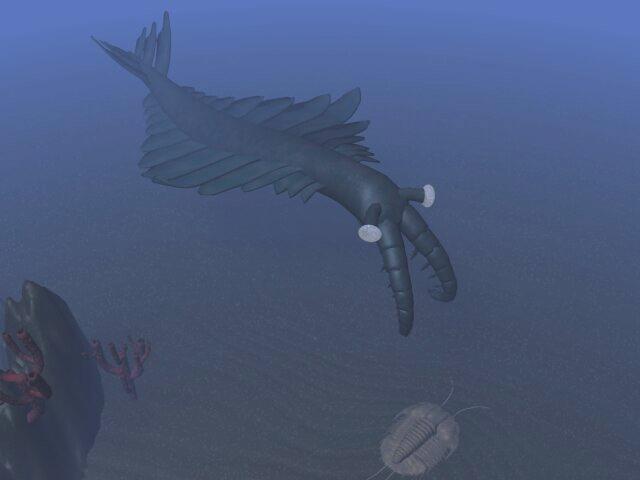- Anomalocarid
image_caption = Artist's reconstruction of an anomalocarid hunting atrilobite .
fossil_range = fossil range|Chengjiang|Burgess shale
superregnum =Eukarya
regnum =Animal ia
subregnum =Eumetazoa
superphylum =Protostomia
phylum = †Dinocarida
ordo =Radiodonta not divided
classis = Anomalocarida
familia = Anomalocaridae
subdivision_ranks = Genera
subdivision =
*"Anomalocaris "
*"Laggania "
*"Cucumericrus
*"Amplectobelua
*"Parapeytoia ?AnomalocarididsFrom latin "Strange
shrimp ". Note that while "Anomalocarid" is a widely used alternative spelling, the double "id" at the end is technically the correct form, for the reasons given in citation
author = Xianguang, H.; Bergström, J.; Jie, Y.
year = 2006
title = Distinguishing anomalocaridids from arthropods and priapulids
journal = Geological Journal
volume = 41
issue = 3-4
pages = 259
doi = 10.1002/gj.1050.] are a group of very early marine animals known from fossils found inCambrian deposits inChina ,USA ,Canada ,Poland andAustralia . Anomalocarids are the largest Cambrian animals known - some Chinese forms may have reached 2 m in length - and most of them were probably activecarnivore s.Characteristics
Anomalocarids were flat free-swimming segmented animals, which in front of their mouths had two appendages that look like the bodies of
shrimp s. The mouth is a peculiar circular structure like apineapple slice, but with a ring of hard sharp teeth in the central orifice. The mouth was more rectangular than round, and the teeth did not meet in the middle. This would still let it crack open shells of smallarthropod s and other like animals, such astrilobite s. Indeed, many trilobites have been found with bite marks on them. Anomalocarids also had large eyes and a body half-flanked with a series of swimming lobes."
Parapeytoia yunnanensis ", one species of anomalocarid (many scientists debate whether or not Parapeytoia was a true anomalocarid, or rather more closely related to Yohoia or Haikoucaris), may even have had legs [http://www.trilobites.info/species2.html] .Compared with many of the other sea-dwelling creatures of its time, anomalocarids were extremely agile. The flaps along its body could probably be moved in a wave-like formation, allowing it to move at great speeds or to 'hover'. This motion could be compared to present-day
Batoidea (rays), or perhapscuttlefish . The shell of the anomalocarids was more flexible than those of its prey, allowing it easier movement.After death this large organism tended to disintegrate and fall apart into separate chunks; the same happened with its moulted skinsFact|date=September 2008 . Completely intact fossil remains of it are very rare. When the fossils were originally described, the jointed arms in front of the mouth were classified as separate arthropods (a large mystery before the fossils were fully reassembled was why these fossils, mistaken as "
shrimp s", were always found without "heads"), the mouth was thought to have been a fossilizedjellyfish called "Peytoia", and the body, thought to be a sponge named "Laggania" was not associated with either. Since the pieces were reassembled in the 1980s, a number of genera andspecies have been described that differ in the details of the grasping appendages, as to whether a tail is present, mouth location, and other features.The name "Anomalocaris" (meaning "strange shrimp") originally referred to the detached arms (which were the first part to be named), and was later used for the whole animal because of the biological name priority rules. Curiously enough, when fully assembled, these animals do strongly resemble (in outside appearance) a gigantic
brine shrimp with a pair of finger-like appendages near its mouth.The anomalocarids thrived in the Early and Mid
Cambrian and then apparently died out. It is possible that largeCephalopods replaced them as the dominant swimming predator at the end of the Cambrian.Classification
Three genera of anomalocarids are known: "
Anomalocaris ", "Laggania ", and "Amplectobelua ". A variety of other related animals including "Parapeytoia ", "Pambdelurion " and "Kerygmachela " are sometimes classified as anomalocarids, but probably belong to different clades.Compared with "Anomalocaris" species, "Laggania species" lacked tail structures and had a considerably larger head with the eyes placed behind instead of in front of the mouth, which would have been disadvantagous for active hunting. Because of these characteristics, some scientists have described "Laggania" as a cruising, plankton feeder.Fact|date=September 2008 "Amplectobelua species", in contrast to "Anomalocaris", were smaller and had a much wider body front with eyes placed lateral to the mouth.
The only plausible close relatives of the anamalocarids are the
opabinid s, another group of enigmatic early forms. The anomalocarids and opabinids are usually considered to be allied to thearthropod s, but they clearly are notcrown group arthropods. In some taxonomies they are placed asstem group arthropods; in others they are given their own phylum,Dinocarida . Some fossils suggest that Anamalocarids and other Dinocarids share a common ancestry with Onychophora, due to the similarities in the fossils to both groups [http://www.trilobites.info/species4.html] . For example Onychophora and Dinocarid joints and segments tend not to be as well-defined and not as clearly separated as most arthropods.Popular Culture
The
Pokémon Anorith andArmaldo are based on this creature.One of the Angels, Sandalphon, from the
Neon Genesis Evangelion anime (episode 10) was modeled after these creatures.Anomalocaris, along with
Opabinia , was the subject of a short story byNeal Shusterman .Anomalocaris is the star of a
Walking with Monsters segment.A gigantic
cyborg mech designed after an anomalocaris, named Accordion Hazard, was featured as one of the five different final bosses of the Taito gameG Darius .ee also
*"
Opabinia "
*"Walking with Monsters "
*"Pambdelurion
*"Kerygmachela Notes
References
* Briggs, Derek; Collier, Frederick; Erwin, Douglas. "The Fossils of the Burgess Shale". Smithsonian Books, 1995.
* James W. Valentine. "On the Origin of Phyla". University Of Chicago Press, 2004.
* Tim Haines & Paul Chambers. "The Complete Guide to Prehistoric Life". BBC Books, 2005.
* Conway Morris, Simon. "The Crucible of Creation". Oxford University Press, 1998.External links
* [http://www.trilobites.info/anohome.html The Anomalocaris Homepage]
Wikimedia Foundation. 2010.

